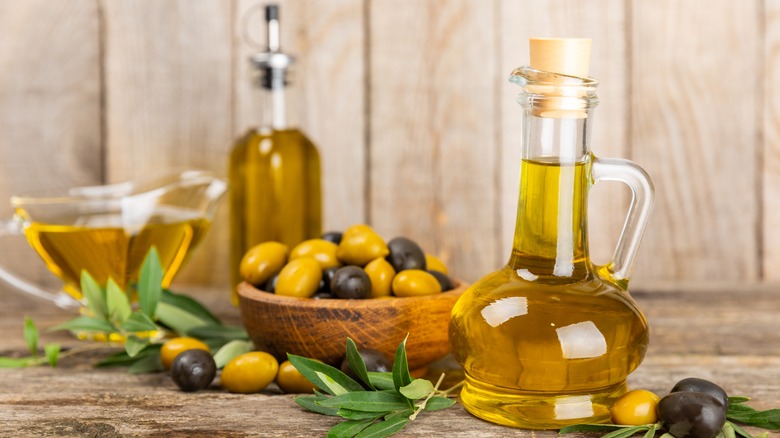Why Martha Stewart Suggests Stocking 2 Kinds Of Olive Oil In Your Pantry
The fruity, grassy essence of extra virgin olive oil (EVOO) is like no other oil, and it's unrivaled for imbuing any meat, fish, or vegetable with a Mediterranean flavor. So it goes without saying that a bottle of delicious and healthful EVOO kept in the kitchen is a wise move. But as Martha Stewart wrote in a piece for Deseret News, you should actually have two bottles on hand. One should be an affordable one for quick cooking, grilling, or baking, and the other a more expensive, premium variety for salad dressings, drizzling over veggies or pasta, or just for dunking bread into.
The variance in EVOO prices has to do with when the olives are harvested and how they're processed. For EVOO, the olives must be unripe or just starting to ripen. The more immature the olive, the greater its polyphenol content. Polyphenols are naturally occurring compounds in plants with antioxidant properties. They give olive oil its distinctive flavor. Ripe, purple olives can be turned into EVOO, but they won't have the same level of polyphenols.
The olives are then mechanically pressed to exude the oil at a temperature no higher than 81 degrees Fahrenheit (27 degrees Celsius) and is thus called cold-pressed. Unripe olives produce less oil, which increases the price, while more oil is exuded from ripe olives, producing a less-expensive version. Once the EVOO has been processed, it then goes through a rigorous certification, which also contributes as to why olive oil is so expensive.
Martha Stewart's tips for keeping olive oil fresh
Extra virgin olive oil is very sensitive to light, temperature, and oxygen, which can result in it turning rancid. Your nose is one of the best indicators for discerning whether it has gone bad. If the oil smells like cucumbers, bananas, or even crayons, then it is most likely rancid. To prolong EVOO's freshness, Martha Stewart recommends keeping your two bottles in a dark, cool place, like your pantry, because sunlight and even florescent lights could damage it. Don't use a pouring spout or store the EVOO in a cruet, as both will expose the oil to air and increase its rate of degradation.
From the time it's bottled, EVOO has a shelf life between 12 to 18 months, so check the "best by" date, which, according to the North American Olive Oil Association, should be at a maximum of two years. When the bottle is opened, it's best to use the oil within 30 to 60 days. Stewart advises purchasing smaller bottles rather than a huge jug, which would be difficult to get through before it begins turning rancid. There are countless recipes to quickly use up your oil, like lemon roasted potatoes or roasted chicken for your cooking EVOO and vinaigrette salad dressing or restaurant-style bread dipping oil for your pricey one.

